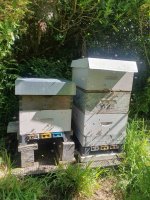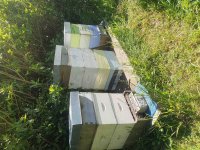We're much very much still learners. Please treat accordingly!
Two hives in a small apiary, both building up nicely but beginning to raise queen cells. Call them A & B. All in 3/4 boxes.
Hive B was artificially swarm-ed by separating the queen on a frame of brood and putting her into a box on the original hive site with a frame of stores either side and the rest drawn comb. A second box of comb and some uncapped honey placed on top.
The frames with queen cells (10 in all) and brood went into another box on a new site 4m away, made up with queen-less brood and more stores in the second box above. This split is flying, bringing back pollen, and we're leaving it alone to hopefully raise a queen. The donor hive is rocking, meanwhile.
Hive A has been brooding, increasing, and storing but for two seasons now we have never once seen a queen and believe us, we tried REALLY hard! Following the artificial swarm guidance we split the hive in two side by side with the swarm cells in the right hand side box of the two but with the brood and stores carefully screened for royalty. On top of the second box was placed a hive mat with a notch upward as an escape and a spare box of frames with a few curious bees inside to store it meanwhile. Interestingly after a day, before the weather packed in, most activity was around the RHS hive, suggesting that a queen was within. There was flying from the hive mat slot too.
Today the southerly let up and the LHS boxes were inspected. Still no queen found, but capped and fresh brood, and two inhabited uncapped queen cells found. No extraordinary numbers of capped drone cells though. The lid was lifted on the spare top box of the RHS hive to discover a fat black queen and maybe 5 incomplete frames of capped and uncapped brood, one queen cell, and fresh stores. At that point we backed away to seek advice.
Advice sought then: What do we do with the queened colony in that top RHS box? Remove it to a new position? Merge it with the LHS boxes since they have been mixing and mingling for a week side by side, and risk a queen fight if they actually have one in hiding? That box cannot become a hive-on-top-of-a-hive and stay. We've run out of day to open the hive below but that has to be a next step, but would really appreciate some guidance meanwhile.
Thank you.
Two hives in a small apiary, both building up nicely but beginning to raise queen cells. Call them A & B. All in 3/4 boxes.
Hive B was artificially swarm-ed by separating the queen on a frame of brood and putting her into a box on the original hive site with a frame of stores either side and the rest drawn comb. A second box of comb and some uncapped honey placed on top.
The frames with queen cells (10 in all) and brood went into another box on a new site 4m away, made up with queen-less brood and more stores in the second box above. This split is flying, bringing back pollen, and we're leaving it alone to hopefully raise a queen. The donor hive is rocking, meanwhile.
Hive A has been brooding, increasing, and storing but for two seasons now we have never once seen a queen and believe us, we tried REALLY hard! Following the artificial swarm guidance we split the hive in two side by side with the swarm cells in the right hand side box of the two but with the brood and stores carefully screened for royalty. On top of the second box was placed a hive mat with a notch upward as an escape and a spare box of frames with a few curious bees inside to store it meanwhile. Interestingly after a day, before the weather packed in, most activity was around the RHS hive, suggesting that a queen was within. There was flying from the hive mat slot too.
Today the southerly let up and the LHS boxes were inspected. Still no queen found, but capped and fresh brood, and two inhabited uncapped queen cells found. No extraordinary numbers of capped drone cells though. The lid was lifted on the spare top box of the RHS hive to discover a fat black queen and maybe 5 incomplete frames of capped and uncapped brood, one queen cell, and fresh stores. At that point we backed away to seek advice.
Advice sought then: What do we do with the queened colony in that top RHS box? Remove it to a new position? Merge it with the LHS boxes since they have been mixing and mingling for a week side by side, and risk a queen fight if they actually have one in hiding? That box cannot become a hive-on-top-of-a-hive and stay. We've run out of day to open the hive below but that has to be a next step, but would really appreciate some guidance meanwhile.
Thank you.




